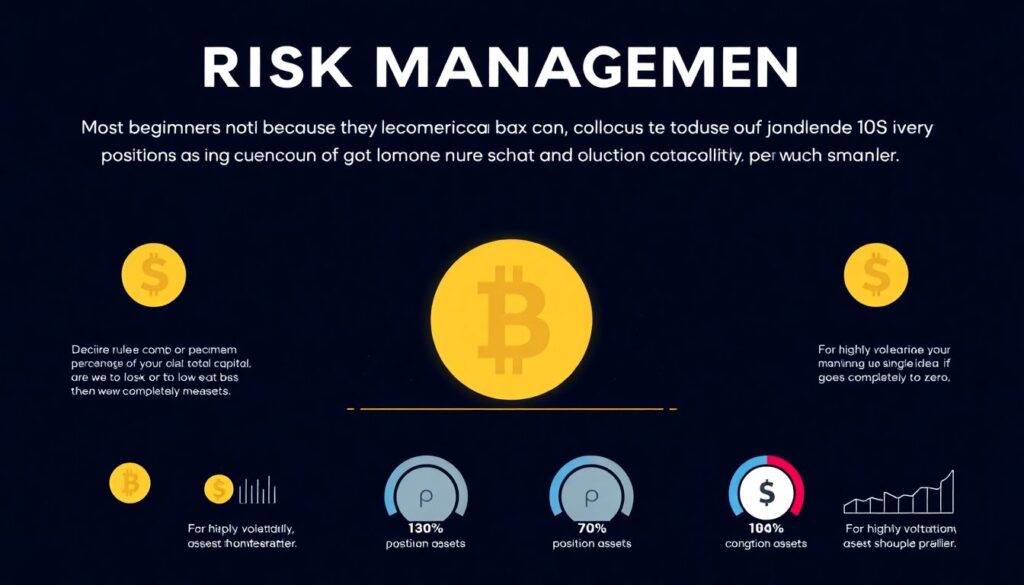Why crypto is so volatile in the first place
Crypto prices move violently because the market is still relatively shallow, highly speculative and structurally fragmented. Over the last three years that’s been obvious in hard numbers: Bitcoin fell roughly 65% in 2022 (from around $47k in January to near $16.5k in December), then rallied more than 150% during 2023. Total crypto market cap dropped from about $2.2T at the 2021 peak to under $800B by the end of 2022, then recovered to roughly $1.7T by late 2023 and about $2.3T by mid‑2024. Annualized realized volatility for BTC often sat between 40–100% in 2022 and compressed toward 20–60% in 2023, far above major stock indices. This backdrop is why you need deliberate crypto risk management strategies instead of trading on gut feeling.
Step 1: Get clear on what “risk” actually means for you

Risk isn’t just “the price might go down”. In practice, risk is the chance that your portfolio behaves in a way that ruins your plans: you panic‑sell the bottom, miss a bill, or blow up your account. Volatility is only one dimension; others are liquidity risk, counterparty risk on exchanges, smart‑contract exploits, and regulatory shocks. Before thinking about how to manage cryptocurrency volatility, write down what you cannot afford to lose in fiat terms and over what time horizon. A long‑term holder who can sit through four‑year cycles has a very different risk profile from a short‑term leveraged trader who needs stable collateral next week. Your personal constraints should dictate position sizing, not the other way around.
Step 2: Understand the main sources of crypto volatility
On shorter timeframes, most sharp moves come from leverage and liquidations. Derivatives open interest in BTC and ETH routinely reaches tens of billions of dollars; when funding rates spike and positioning becomes one‑sided, even a modest move can trigger cascading forced sells or buys. Over the 2022 bear market several single days saw more than $1B in leveraged liquidations across major exchanges, amplifying price swings. On longer horizons, macro events (rate hikes, liquidity cycles), regulatory news and narratives around technology (DeFi, NFTs, layer‑2s) dominate. Thin order books on smaller tokens mean that a single large seller can move prices by double digits. Recognizing which driver is in control helps you choose appropriate crypto volatility hedging strategies instead of reacting blindly to headlines.
Step 3: Use position sizing as your first line of defense

Most beginners blow up not because they choose a “bad coin”, but because they size positions as if volatility were low. A simple rule of thumb: decide the maximum percentage of your total capital you are willing to lose on a single idea if it goes completely to zero, then work backwards. For highly speculative altcoins, many disciplined traders cap this at 1–2% of portfolio value, while majors like BTC or ETH might get a slightly higher allocation. If a 50% drawdown in one asset would cause you to lose sleep or break your budget, your position is too large. Good crypto risk management strategies start with boring arithmetic; without that, no indicator or on‑chain metric is going to save you from emotional decisions when the market moves against you.
Step 4: Build a portfolio instead of a bag of random coins
Treat your holdings as a portfolio with roles for each asset: core, satellite, speculative. A common approach is to keep a core allocation to BTC and ETH, a moderate slice for higher‑beta sectors such as DeFi or gaming, and a small “venture‑like” bucket for early‑stage tokens that might go to zero. Over 2022–2023 correlations between major coins often spiked during crashes, meaning diversification within crypto only partly reduces drawdowns, but it still smooths idiosyncratic blow‑ups like individual protocol hacks. If you manage multiple exchanges and wallets, using the best crypto portfolio risk management tools you can find—dashboards that aggregate balances, PnL and historical volatility—helps you see concentration risks you might miss when looking at accounts in isolation.
Step 5: Set rules for entries, exits and maximum loss
Pre‑defined rules turn chaotic markets into something you can operate in calmly. Decide in advance where you’ll cut a losing trade (for example, 10–20% below entry for a short‑term setup) and where you’ll take partial profits. A basic risk‑to‑reward rule such as “I only take trades where potential upside is at least twice the downside” forces selectivity. Over the last three years, BTC and ETH repeatedly saw 20–30% pullbacks even within broader uptrends; without a plan, it’s easy to sell the dip and buy the rip. Use stop‑loss orders, but be aware of wick hunts on illiquid pairs; on small caps, it can be safer to use mental stops and reduce size than rely solely on exchange mechanics that can slip badly during spikes.
Step 6: Learn specific hedging and volatility‑control techniques
For larger portfolios, you can go beyond simple spot buying and selling. Classic crypto volatility hedging strategies include holding a portion of your wealth in stablecoins, shorting perpetual futures against long spot positions during overheated phases, or buying put options as insurance before known event risks like major unlocks or regulatory decisions. Through 2022–2023, traders who systematically trimmed exposure when funding rates were extremely positive, or who shorted frothy altcoins while keeping core BTC/ETH, often saw smaller drawdowns than pure holders. Be cautious with options Greeks and margin requirements; hedges can themselves become sources of loss if you don’t understand how they behave under stress, especially when implied volatility collapses after big moves.
Step 7: Manage exchange, protocol and counterparty risk
Price charts do not show the risk that your venue itself fails. The collapse of several centralized platforms between 2022 and 2023 reminded everyone that even if you “picked the right direction”, you could still lose funds. Reduce reliance on any single exchange, prefer venues with robust proof‑of‑reserves and transparent governance, and avoid holding long‑term capital on margin accounts. On the DeFi side, smart‑contract exploits and oracle failures continue to be a material risk; audits help but are not guarantees. Diversify across protocols and chains, and keep a habit of withdrawing to self‑custody wallets you control. A sophisticated trading system is useless if a single unexpected freeze or exploit locks up the capital you thought was strategically positioned.
Step 8: Use data and tools instead of trading by emotion
Volatility feels much scarier when you don’t quantify it. Check realized volatility, average drawdown and recovery times for the assets you hold; many analytics sites now provide multi‑year history, showing, for instance, that 50% pullbacks in BTC within a macro cycle are historically common. Over 2021–2023, several metrics—liquidation heatmaps, funding rates, and open interest—gave advance clues when leverage was stretched and a squeeze was likely. Incorporating these into your process doesn’t require being a quant; it’s enough to glance at whether leverage is historically high before aping into momentum. Over time, the best crypto portfolio risk management tools are the ones you actually check regularly, even if they are simple dashboards, not complex institutional terminals.
Common mistakes beginners make (and how to avoid them)
New traders often repeat the same errors: going all‑in on a single narrative coin, using high leverage “just to accelerate gains”, and averaging down endlessly without a plan. Many also confuse paper gains in bull phases with skill, then scale up size right before the market regime shifts, as happened for many between late 2021 and the brutal 2022 bear. To counter this, treat your first year as an informal cryptocurrency trading risk management course you give yourself: cap total capital at an amount you can lose, keep a trading journal of entries, exits and emotions, and review monthly. The goal is not maximum profit but maximum learning per dollar of risk, so that by the time the next major trend arrives, you’re structurally prepared.
Practical tips for newcomers in 2025 and beyond
By 2025 the market is more mature than in 2017, but the patterns rhyme: cycles of optimism and despair, new sectors getting overheated, and regulators catching up. Assume future volatility will at least resemble the last three years: sharp 50–80% drawdowns in alts, multi‑month sideways periods, and occasional parabolic spikes. Start small, focus on understanding how to manage cryptocurrency volatility before chasing complex derivatives, and be skeptical of anything promising “risk‑free yield”. Diversify across time as well as assets by scaling in gradually instead of deploying all capital at once. And remember that the best edge most individuals can cultivate is staying solvent, liquid and emotionally stable long enough to participate in the upside when the inevitable next expansion phase arrives.

